
Foghatnánk a fejünket, hogy na tessék, én is az unos-untiglan ismert, "ha Pisa, akkor Ferde torony" örökzöld témát feszegetem, ehelyett irkálhatnék inkább másról. Na, de kérem, most jöttem Pisa-ból, ahol először láttam ezt a furcsa szerzetet, és másztam fel a Ferde toronyba, ami mellett nem mehettem el kép-szó-bejegyzés nélkül, kicsi szívem legmélyén remélve, hogy sikerül a téma ellenére is újat mutatnom. Nekem új volt, és állíthatom, Pisa nem egyenlő a Ferde toronnyal, ámbár a bejegyzés témája csupán ez lesz most.
I love that part of Pisa what I have seen already and I was impressed by the Leaning Tower as well. Let me introduce the Leaning Tower to you how I saw it.

A Csodák tere avagy Csodák mezeje (Campo dei Miracoli avagy Dóm tér) keletkezése a XI-XIII. századra datálható, amikor is Pisa, köszönhetően az Arno folyónak kiterjedt kereskedelmet folytatott, s a régió egyik meghatározó városa volt. Kereskedeleme kulturális forradalmat hozott, és gazdagságának köszönhetően elkészültek a tér csodálatos, főként fehér márvány felhasználásával épült mór és római hatásokat is mutató építményei. Habár maga a torony szolgál leginkább rá a ferde jelzőre, azt tudnunk kell, hogy a többi építmény is diszkréten, de megdőlt a téren, s ezáltal bizony ferde mind. Kajlaságuk oka, hogy homokos, hordalékos, agyagos talajara épültek. Ferdeségük - na nem annyira, mnt a toronynál, de - szemmel látható, különösen a Dóm épületén látjuk, ahogy kint elsétálunk mellette, de a Temető (Campo Santo) is igazán hepe-hupás.
The Square of Miracle was formed between 11th-13th centuries when Pisa was a leading commercial town of its neighborhood, thanks for River Arno. Thanks for the cultural revolution and wealth of Pisa, caused by the commerce these buildings were built from white marble and affected by arabesque and roman styles. You might not recognize it at first sight, but all buildings, including the Cathedral and the Cemetery (Campo Santo) as well are leaning because of the quality of the sandy ground.


Toszkánai szokás, hogy a Keresztelőtemplom (Battistero) és a Dóm (Duomo) funkcióit két külön épület tölti be.
The Baptistry Church (Battistero) was built separately from the Cathedral as usual in Tuscany.

A Ferde Toronyba csupán másodszorra sikerült belépnünk. Délelőtt 11 óra körül érkeztünk meg, és munkamegosztás címén egyikünk bevágódott a torony előtt kacskaringozó sorba, míg másikunk elment jegyet váltani. Bevágódásom (merthogy én voltam a sorban álló) csaknem teljesen haszontalan volt, leszámítva azt, hogy egy segítőkész idegenvezető felvilágosított, hogy az A3-as méretű laptáskámat nem vihetem fel a toronyba, hanem azt az akkor még nem létező (éppen váltás alatt álló) jegyemen feltüntetett időpont előtt tíz perccel le kell adnom a teljesen biztonságos szekrénykékből álló értékmegőrzőben.
If you wish to enter the Leaning Tower, you need to buy a ticket and leave all your stuffs and bags (except your camera) in the locker. We tried to enter the Leaning Tower at 11.00 a.m., but we could buy ticket only for that tour which started at 13.00 p.m.

A Ferde torony környéke tele van árusokkal, ahol (valószínűleg) a Távol-keleten gyártott olasz pisai ferde tornyok tömkelegét árulják.
The area, around the Leaning Tower is full with stalls which sell the cheap and different size copies of the Leaning Tower.

S valóban, a megváltott jegyünk nem délelőtt 11-re, hanem délután 13 órára szólt, amely két időpont között cirka kettő órácska kellette magát. Ám aggodalomra semmi ok. A baromi drágán vett kombinált belépőnk egyik előnye (avagy egyetlen előnye, bár hátránya az árán túl nem volt egy sem) volt, hogy a Csodák tere minden építményét felkereshettük vele, így volt mivel kitölteni az üres(kényszer)járatot.
Our visiting time was printed on our ticket. As I mentioned we were allowed to visit the tower at 13.00, therefore we had plus two more hours to visit everything around the tower on the Cathedral Square i.e. the Cathedral, the Baptistry and the Cemetery. We purchased a combined ticket which was quite expensive, but it's worth that price.


Ebben a két órában néztük meg a Keresztelőkápolnát (amelyből csuda egy kilátás nyílik a Dómra és a Ferde toronyra), kerestük fel kétszer a Dómot (miséztek, így csak harmadszorra, a torony meglátogatását követően jutottunk be úgy, hogy az egész épületet bejárhassuk), jártuk végig a Temetőt és ittunk egy-egy jóféle kapucsínót, megtámogatva a vércukrunkat is egy-egy nem kevésbé finom süteménnyel.
The view of the Cathedral and the Tower from the Baptistry.
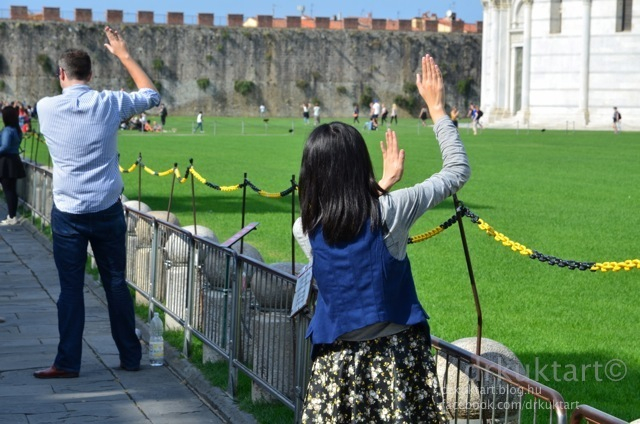
Na igen, nem árulok zsákbamacskát, ha elárulom, hogy ezen serény kezek mind a tornyot támasztják.
Both of them are 'working' on the tower.

Kukucs, a torony szégyelősen kihajol a Dóm mögül.
This is how the shy tower is winking at us behind the Dome.

Hogy a Ferede torony történetével se maradjak adós, elárulom, hogy a hozzávetőleg 56 méter magas, hétemeletes harangtorony első három szintje 1173-1178 között épült. Már a harmadik emelet elkészültekor a Ferde torony elkezdett süllyedni, ami nem csoda, ha hozzávesszük, hogy az építmény egy mintegy három méter vastag alapon áll, és a talaj összetétele főként homok és agyag. Ezt követően az építkezés Pisa folyamatos hadban állása miatt szünetelt, s majdnem száz év kellett ahhoz, hogy a torony építését folytassák 1272-ben. Ekkor további négy emeletet építettek, majd leálltak. A hetedik szintet teljes egészében 1372-ben fejezték be, majd szépen sorban elhelyezték a torony tetején azt a hét darab harangot, amelyek súlya alatt a torony méginkább megdőlt. A Ferde torony kiegyenesítésén sokan és sokáig fáradoztak, amely leginkább azt eredményezte, hogy az építmény méginkább eltért a függőlegestől.
And what about the history of the Leaning tower? 'Construction of the tower occurred in three stages across 199 years. Work on the ground floor of the white marble campanile began on August 14, 1173, during a period of military success and prosperity. This ground floor is a blind arcade articulated by engaged columns with classical Corinthian capitals. The tower began to sink after construction had progressed to the second floor in 1178. This was due to a mere three-metre foundation, set in weak, unstable subsoil, a design that was flawed from the beginning. Construction was subsequently halted for almost a century, because the Republic of Pisa was almost continually engaged in battles with Genoa, Lucca, and Florence. This allowed time for the underlying soil to settle. Otherwise, the tower would almost certainly have toppled.[citation needed] In 1198 clocks were temporarily installed on the third floor of the unfinished construction. In 1272 construction resumed under Giovanni di Simone, architect of the Camposanto. In an effort to compensate for the tilt, the engineers built upper floors with one side taller than the other. Because of this, the tower is actually curved. Construction was halted again in 1284, when the Pisans were defeated by the Genoans in the Battle of Meloria. The seventh floor was completed in 1319. It was built by Tommaso di Andrea Pisano, who succeeded in harmonizing the Gothic elements of the bell-chamber with the Romanesque style of the tower. There are seven bells, one for each note of the musical major scale. The largest one was installed in 1655. The bell-chamber was finally added in 1372.' (References from here.)

Végre eljött a mi időnk, a 13 óra. Táskák leadva azzal, hogy a fényképezőgép nem akadály, így felvitele engedélyezett. Elvileg negyedóránként legfeljebb 45 embert engednek fel, akik mindösszesen 15 percet tartózkodhatnak a toronyban. Ez a 15 perc magába foglal egy rövidke előadást, majd a toronyba való folyamatos felkutyagolást, gyors körsétát az első kilátó szinten, majd kicsit hosszabb tartózkodást és a kamera előtti pózolást a második szinten, ahonnan aztán leterelik a jó népet annak érdekében, hogy a következő csoport is kiteljesedhessen. Persze ez a 45 fő gyakorlatilag soha nem ennyi, mert leginkább több (gyors fejszámolást követően úgy 90 főre tippelnék): a csoportok átfedésben vannak, míg az első kilátó szinten várakozunk, a korábbi csoport éppen akkor vonul le a második szintről (a picinyke harmadik kilátó szint nem látogatható). Tanulságként annyit megosztanék, hogy hiába van kitűzött időpontunk, akkor is érdemes várakozáskor a sor elejét becélozni, tekintettel arra, hogy bár a jegyek beolvasása, így a belépés folyamatos, a torony történtetét ismertető hölgy nem várta be mind a 45 fő beérkezését (mi a sor végén voltunk, köszönhetően kevésbé türelmes, de inkább tolakodó és a sorban elénk törő, nekünk emiatt ellenszenvessé váló majdnem egy tucat turistatársunknak, akik mint említettem a jómodorral ellentétben benyomták testüket elénk), hanem már az első pár ember megérkeztekor belekezdett a mesébe, így történhetett az, hogy mikor mi is beléptünk végre a toronyba, a hölgy pontot tett mondanivalója végére és kiadta a vezényszót: előre.
Finally our time has arrived at 13.00 p.m. We left all of our bags in the locker (they say the lockers are extremely safe). They say only 45 people are allowed to be in the Leaning Tower in the same time and the tour takes 15 minutes. During this time a short presentation about the history of the tower was presented, then you had to walk up to the top. I would recommend to stand at the beginning of the queue because the lady who held the presentation, didn't wait for all 45 people to arrive. We were the last ones and missed almost the whole story.

Köszönhetően a torony ferdeségének a lépcsőkön hol azok bal-, hol azok jobboldalán, hol azok közepén iparkodunk felfelé, amit a lépcsők kopása is megfelelően érzékeltet. Ha nem lennénk tudatában létezésünk mindenegyes másodpercében a gravitációnak, azt igencsak érezzük akkor is, amikor ellen kell tartanunk a nekünk éppen hátrafelé dőlő toronynak, és vica versa. Érdekes érzés.
Thanks for the fact, that this tower is leaning the stairs are used on different parts: in the middle, on the right or the left side, depends on the direction of the given part of the tower.


Kilátás az első kilátó szintről. A Via Santa Maria sarkán a "kávéházunk" a Café Pasticceria I Miracoli, aho elütöttük a várakozási idő egy részét. Hogy mit ettünk és ittunk, azt itt mutatom meg Nektek. Mmmm.
The view from the first balcony of the tower. On the corner of Via Santa Maria, the nice café where we had good cappuccino and desserts, is located. You can check what we ate and drink in Café Pasticceria I Miracoli here, jummmmmy.




A második kilátó szintre vezető csigalépcsők.
Stairs to the top.

A sok kis munkás kéz tulajdonosa lent pózol, és ellentart. Van, akinek ez hídban is megy.
The posers.

A harang az függőleges, míg a torony nem az.
The bell is hanging vertically, however the tower isn't vertical.

Az eredeti korlát mögé és fölé egy magasabb és újabb hálót emeltek az egyéni turista attrakciók megelőzése végett. A látvány szempontjából ezt csak annyival kommentálnám: kár.
The second floor of the viewpoint is protected by an old and a newer fence.




Az utókor szorgos munkálkodásai a több száz éves harangokon.
'Modern art' on the more hundred-year-old bells.


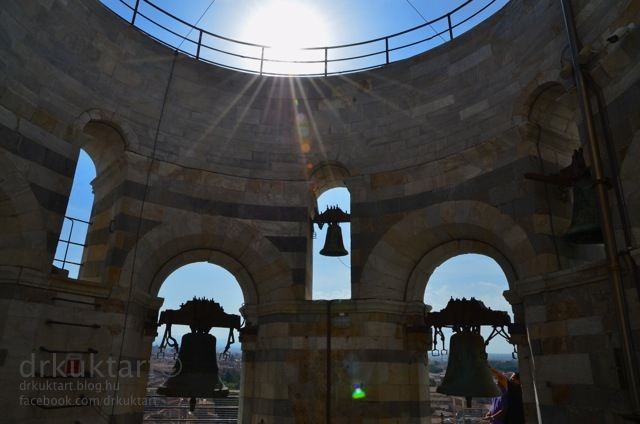
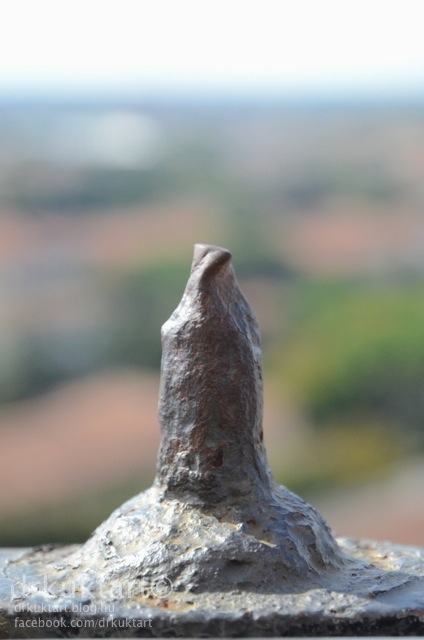
A régi korlát.
Old fence around the second floor of the balcony.
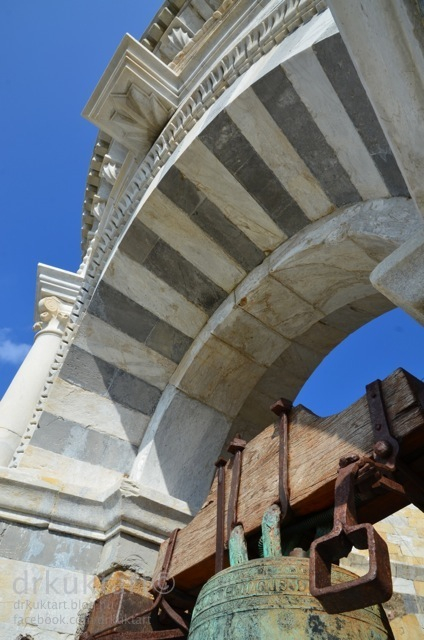


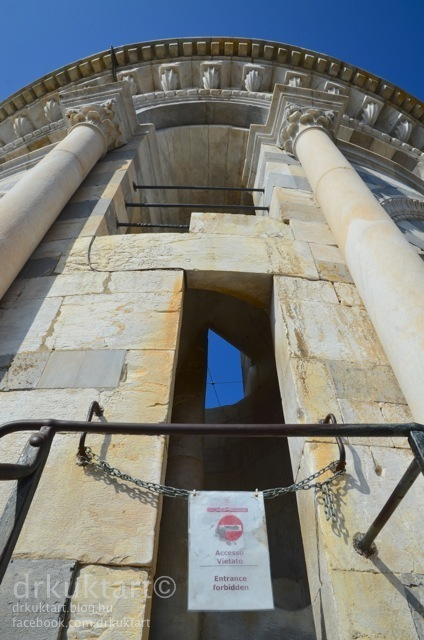
A harmadik kilátó szintből nekünk csak ennyi jutott.
The third floor of the viewpoint is closed.

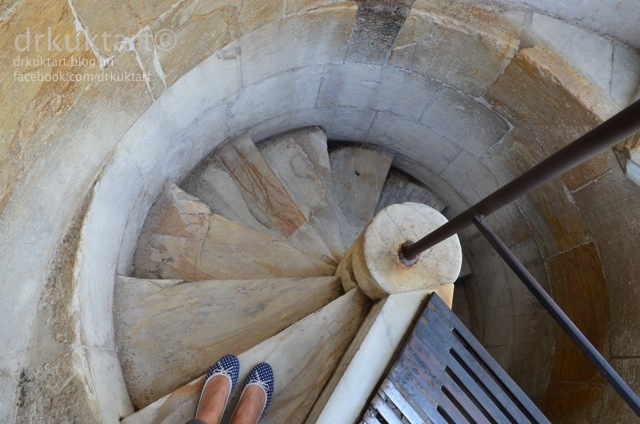

Háttérben a futballstadion, az előtérben Romulus és Remus az anyafarkassal.
In the background the football stadium is located and Romulus and Remus and the wolf in the forefront.






"Úgy tartják, hogy Galileo Galilei két különböző tömegű ágyúgolyót dobott le a toronyból, hogy bebizonyítsa, az esési sebesség nem függ a tömegtől. Noha ezt a történetet Galileo egy tanítványa terjesztette, ma már legendának minősítik. (…) 1964-ben az olasz kormány segítséget kért, hogy megelőzzék a torony leomlását. Egy nemzetközi csoport (mérnökök, matematikusok és történészek) állt össze, hogy megbeszéljék a stabilizálás módszereit. Húsz évnyi munka után, 1990 januárjában a tornyot lezárták a nagyközönség elől. A harangokat elszállították, hogy a terhelés csökkenjen, és a harmadik szintről kábelekkel "lehorgonyozták" az építményt. Biztonsági okokból a torony körüli házakat kiürítették. Tíz évnyi restaurálás után 2001. december 15-én a tornyot ismét megnyitották a látogatók számára. A nyilatkozatok szerint a torony további 300 évig stabil marad." (Forrás innnen.)
'Galileo Galilei is said to have dropped two cannonballs of different masses from the tower to demonstrate that their speed of descent was independent of their mass. However, this is considered an apocryphal tale, its only source being Galileo's secretary. (…) On February 27, 1964, the government of Italy requested aid in preventing the tower from toppling. It was, however, considered important to retain the current tilt, due to the role that this element played in promoting the tourism industry of Pisa. A multinational task force of engineers, mathematicians, and historians gathered on the Azores islands to discuss stabilisation methods. It was found that the tilt was increasing in combination with the softer foundations on the lower side. Many methods were proposed to stabilise the tower, including the addition of 800 tonnes of lead counterweights to the raised end of the base. In 1987 the tower was declared as part of the Piazza del Duomo UNESCO World Heritage Site along with the neighbouring cathedral, baptistery and cemetery. On January 7, 1990, after over two decades of stabilisation studies, and spurred by the abrupt collapse of the Civic Tower of Pavia in 1989, the tower was closed to the public. The bells were removed to relieve some weight, and cables were cinched around the third level and anchored several hundred meters away. Apartments and houses in the path of the tower were vacated for safety. The final solution to prevent the collapse of the tower was to slightly straighten the tower to a safer angle, by removing 38 cubic metres (1,342 cubic feet) of soil from underneath the raised end. The tower was straightened by 45 centimetres (17.7 inches), returning to its 1838 position. After a decade of corrective reconstruction and stabilization efforts, the tower was reopened to the public on December 15, 2001, and was declared stable for at least another 300 years.' (References from here.)


A torony be-kijárata.
The entrance (and exit) of the Leaning Tower.








Ha tetszett a bejegyzés, kövess Facebook-on ITT és Instagram-on ITT.
Szép napot kívánok!
If you like this post, follow me on Facebook HERE or Instagram HERE.
Have a nice day!
DRKUKTA

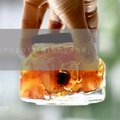



kriskop 2014.10.20. 18:40:35
drkuktart 2014.10.20. 18:43:47